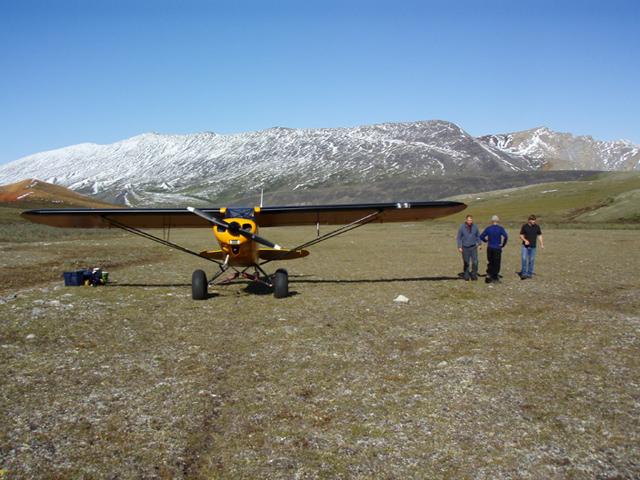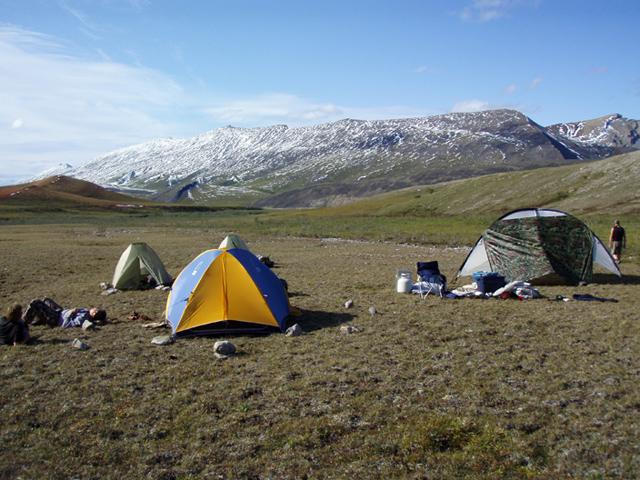12th August
The sun's path in the sky over the tundra seems strange.
In the early morning it rises quickly, and manages to reach the edge of the horizon; but it doesn't get much higher. It then travels for almost 3/4 of a circle before disappearing late at night. It gets very little rest as the night only lasts a few hours, and even then it is only twilight, not real darkness. I haven't experienced real darkness since Anchorage. Anyone who goes hunting on Brooks Range in the summer needn't worry about stocking up on batteries for torches.
The morning in Kavik Camp begins with the obligatory dress-rehearsal for any hunt: the testing of the



Chapter II.: Hunting in the Alaskan Arctic
Page 31
guns. We cross to the other side of the runway. The blue plastic barrel that I rest on to take aim is slightly wobbly, so I place my pack on it to stabilize it. There's no chair, so I can't sit down, and there's only one point, not two, to rest my gun on. This is a problem, because when testing the gun I'm not trying to test myself; I just want to find out if the gun's settings have changed. One of the guides, doing it just by eye, places the target at 300 ft exactly. I know this because I checked it twice with my laser gunsight. A few days ago I bought an automatic target from Sportsman's Warehouse; what happens is that, if you hit it, the black turns orange. So you don't need to drag yourself over to the target each time to see if you have hit it. I'm still trying to balance my gun, standing up and bending forwards, wearing my Peli earmuffs, and being stared at by six Americans standing behind me.
What a relief!
It's as if a huge burden has been lifted off my shoulders.
I aimed for the base of the black target, so the SST should have hit the 10-mark on it, as this is the amount the bullet should have risen over its 300ft flight, if the gun is properly calibrated for a distance of 750ft. I can relax: an orange spot has appeared in the middle of the black. It's a hit, and gives my self-confidence a boost - you can't hunt in the mountains if you don't have confidence in yourself and your gun, and now I feel that I'll have no problems with my gun.



Chapter II.: Hunting in the Alaskan Arctic
Page 32
If my gun-sight was considered a hit among the security guards at Chicago airport, then I must say that here it is an overwhelming success. Greg even asks me if I can get his painted in the same way.
My gun passes from hand to hand, and all the Yanks are grinning.
After the shoot, I waste no more time and get straight into Greg's plane. It's very small inside, and we have to sit behind each other. I have no other option but to hold on tightly to my gun. In front of us and to our right, Brooks Range is approaching, and it soon encircles the brave little yellow-plastic kite. We are not put off by the peaks, and head right for them. Now the mountains are lying parallel to us and we only need to make a slight alteration to our course to fly down into a valley. Here we have snowy peaks on either side; we have left the open sky behind. The sunshine reflects blindingly off the snow, and as I have left my glacier-glasses in my rucksack, I am blinking non-stop. The dark-green tundra-grass of the plain provides a stark contrast to the shining peaks. Becase of the mild weather of the last few days the snow-line has begun to rise, but Brooks Range is still dazzlingly white; the greenery has not yet won the battle.
We fly down the valley.


Chapter II.: Hunting in the Alaskan Arctic
Page 33
Greg is constantly on the radio, keeping in touch with the other plane, which, apart from the pilot, is carrying another guide. Greg's colleague lands his white plane in a suitably snow-free part of the valley. We are also heading towards this temporary runway, but at the moment we are too high, so he revs the engine and we make a new approach. We fly over the smooth-looking plain once more. This time Greg leaves nothing to chance; we practically stop in the air, and then start to descend almost in a glide, down over the withered grass. The plane touches down, but the huge tyres make us bounce up three times before we finally stop.
We unload the plane.
According to the GPS we are over 35 miles from Kavik Camp, and we were flying for 30mins. Bruce, one of the guides, who was a passenger in the other plane, is a thick-set man of around 60. On the other side of the "airport" is a little stream, so everything has to be carried over it to the place that will become our campsite.
Just as I am about to lend a hand with the first load, and pick up my gun, Bruce stops me. He has already taken over his gun, and it is important that there is at least one remaining here until everything has been moved to the other side. Bears are a very real danger here. Yesterday, while out shooting birds, we saw some bear tracks. It might have been one of the animals that Susan mentioned. I didn't feel very calm or relaxed; a .410 shotgun is not an ideal weapon for killing bears. Bruce's gun is different. He has a Remington 700 in .35 Wheelen caliber.
In Alaska there are many types of caliber, which you will never find in Hungary.
We unpack all the camp equipment, including a Coleman stove, gas cylinders and lots of boxes of food. Bruce begins setting up the camp, and I start writing my diary. I left my netbook behind in Kavik, as there would be no chance of recharging the battery out here. I have had to switch over to scribbling, and I put all my notes down in a copy-book.
The weather really could not be better.
The sky is clear, and it's warm enough for me to wear short sleeves. The experienced Bruce produces a pair of shorts from the bottom of his rucksack. We are camped near to the stream, which is crystal-clear, drinkable and very cold.
These Alaskan guides are interesting people. They are not over-attentive to their clients. If you ask for something, they will certainly do it, but they are not always hovering over you, asking how you feel every five minutes, and if everything is alright. They probably think that if the client wants something, he will ask for it. They treat us all like adults, and expect everyone to act responsibly. They don't say a word if the client walks around with a gun over his shoulder: they take it for granted that he will not shoot anything without permission.
In this clear air it's difficult to judge distances accurately. I've just been aiming at a nearby moutain



Chapter II.: Hunting in the Alaskan Arctic
Page 34
which registers as 660ft away on my gunsight; I wouldn't have said it was more than 450ft.
Planes are landing again, and in one of them is Jay, with whom I've been inseparable since Deadhorse. He's arrived just in time. Two caribou have been seen, but they are far away. They are grazing on the new grass, beyond the 3000ft range of my laser. For several long minutes I stare at them through my Swarovski sight. Since I've been here, I've seen many types of animals, so the
"silence of the North" does not seem particularly characteristic of the relatively small area that I have so far seen.
Putting up the tents is not easy, and we have to refer to the insruction manual. Bruce uses a huge thigh-bone as a hammer to pound in the tent pegs. I join in, and bring up some heavy stones from the creek to help stabilize the tents. Altogether, we put up six tents. Jay and I will each sleep in tiny one-person mountaineering tents. There's very little space inside, and it's not very convenient. The boy who was so successful yesterday with the shotgun, is sharing a large tent with Mark, his father; they will mainly be hunting grizzlies. We then have a dining-tent, which is really just a strip of canvas, and finally there are the guides' tents. There are three, which is a good sign. It means that each hunter will have his own guide.
So, this is what my new Alaskan hunting camp looks like. It's just as I expected it to be.


Chapter II.: Hunting in the Alaskan Arctic
Page 35
The planes continue to go back and forth many times until everything has been brought from Kavik Camp. Mark, the grizzly-hunter, fills the magazine of his over-size .375 caliber Holland&Holland Magnum rifle with Federal ammunition, comprised of 270 grain Power Shock bullets. We're all quite sure that the caliber that he has chosen will not be too small. True to character, he has brought along a lot of beer and whisky. I'm angling for a beer. It's ridiculous that so far, up here in the Arctic Circle, I haven't been able to get my hands on a beer. Mark's son, armed with a .270 caliber Winchester, is setting off after the caribou.
We are finally on the hunting grounds!
We are living in tents, looking at the mountains, and lying on the grass!
The hunt has begun, and I have absolutely no worries!
RAM!
The peace of the camp is broken by Jay's shout. It suddenly springs to life and everyone grabs their binoculars. A white dot is moving on the hillside opposite us. We're all getting very excited.
Where's my spotting scope! We all watch it through our x40 optics... but we can only see its rear... Now it's turning... That's it! That's a ram. Its horns form a complete circle, but we can't see the tips because of the distance. We can't restrain Jay; he straps his gun to his back and heads off, looking for a path leading to the ram. His impatience is understandable, as for the last three years he has been trying, in vain, to shoot a Dall sheep. Now he's swearing by all the gods that this white-coat will not get a chance to escape. Come what may, he has to wait until tomorrow because we only arrived today. We watch the bighorn for over two hours without having to alter the spotting scope’s range. It's a useful experience. If ever I manage to get anywhere near a ram, I'll certainly have time enough to take aim. Jay soon returns; he will try to find the way with his guide tomorrow.
In the evening Greg flies in yet again; who knows how many times he's been coming and going?
He has good news: there are not less than 13 rams in the vicinity! On hearing this, Mark opens up his bottomless beer-bag. As a result of the ram-sighting, combined with the beer, we're all in an excellent mood, and looking forward to dinner. Bruce has cooked us a delicious spaghetti in a tomato sauce, which we eat standing up, sitting down or simply sitting on the ground.
Just as hunters in Alaska should.


Chapter II.: Hunting in the Alaskan Arctic
Page 36
Sheep and Caribou Camp


















